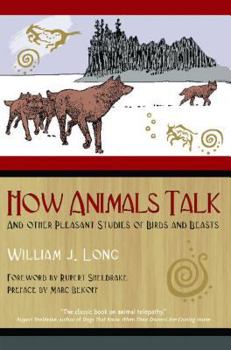How Animals Talk: And Other Pleasant Studies of Birds and Beasts
Select Format
Select Condition 
Book Overview
The classic and original text that first explored the telepathic methods of communication of wild animals - Based on years of detailed field observations, first published in 1919 - Written by the famous American naturalist who was the first to study telepathy in the wild - Forewords by biologists Rupert Sheldrake, who has spent 15 years researching the unexplained powers of animals, and Marc Bekoff, the editor of the three-volume...
Format:Paperback
Language:English
ISBN:1591430569
ISBN13:9781591430568
Release Date:August 2005
Publisher:Bear & Company
Length:312 Pages
Weight:0.91 lbs.
Dimensions:0.8" x 6.1" x 9.0"
Customer Reviews
2 ratings
Exceptional except for...
Published by Thriftbooks.com User , 18 years ago
The prior review by Getty explains overall content of the book wonderfully, so I will refrain from adding to an exceptional review. However, there is one area that was not mentioned that brought my review down to four stars. I understand that this book was written almost 100 years ago, and people interacted with nature a bit differerently. Hunting was accepted and needed, and I understand that. However, Long writes a great deal about stalking, flushing, tracking, calling, and killing animals. He never mentions if he's killing for meat, but there are occasions when he tracks and tries to kill animals, such as wolves, that he clearly will not be eating. One example - he mentions how he kills crows when he can, for they ravage the nests of the beneficial birds who keeps gardens healthy. I found this irritating: the man feels his killing as many crows as he can is acceptable, for they destroy the birds that are beneficial to man. I could not understand how this man, who is obviously very connected to nature and animals, could kill so easily and makes so little mention of it. I was confused, and frankly, dismayed many times as I read Long's accounts in the field, often with rifle in hand, ever ready to call a moose with his developed calling skills and then shoot the animal. I had a hard time in places in the book due to Long's choice to hunt and kill the animals he also found so interesting, animals he clearly respected. However, in one of the later chapters, he mentions how he does not approve of killing animals, yet throughout most of the book, he never went out without his gun, often using familiar animal calls to attract animals, so he could shoot them, not just observe them. It felt contradictory. He particularly had no remorse for shooting crows and related his actions with what felt like self-satisfaction and justification.
Enchanting and Life Changing
Published by Thriftbooks.com User , 18 years ago
This book, first published in 1919, is quite remarkable. William Long was a pioneer in the then new field of animal behavior. Though he did not call it that: he was simply a naturalist who had a great love of Nature. The book is broken into three segments. The first is "How Animals Talk." Second is "How to Know the Wood Folk," and finally "My Pond, A Symphony of the Woods." The first section is nothing short of an essay on his observations on telepathy in both wild and domesticated animals. He describes something known by a great many of us who live with animals: they often seem to know when we are coming home unexpectedly. This was written almost 80 years before Rupert Sheldrake began to generate some empirical evidence to support these observations, which he published in a number of research papers and in the book Dogs Who Know When Their Owners Are Coming Home, which I also recommend very highly. Long also describes experiments that appear to demonstrate that animals know when they are being looked at. Sheldrake has also gathered data showing this to be a real phenomenon. (See if you can wake a sleeping dog or cat by staring at them: the results are often remarkable!). William Long talks about an African term - chumfo - that is a kind of super-sense that we and all creatures are said to possess, which is a perfect coordination of all the other senses. Something in which animals excel, and humans often do not. But this is superseded by the ability of animals to sense events at a distance. After the terrible tsunami at the end of 2004, there were multiple reports of wild animals having run to high ground before the tsunami arrived. I spent several days checking the reports to see if they were just an urban legend, but they appeared to be absolutely true. I put these observations in the same group as animals being used in China to issue earthquake warnings, and the reports in this book by William Long. What Long is telling us in this book, and what Sheldrake's experiments seem to confirm, is that unexplained abilities like the sense of being stared at and telepathy are not paranormal, but normal, and part of our nature. Clearly if only one species had telepathic or supersensory abilities, it would have such a biological advantage that it the balance of Nature would be overturned. Not so if all animals have these abilities to some degree. This is handsomely produced book replete with several color paintings. In addition to the text, there is a forward by Rupert Sheldrake and a Preface by the eminent animal behaviorist Marc Bekoff from the University of Colorado. This book is enchanting and if you drink in its wisdom, it could be life changing. Highly recommended!






